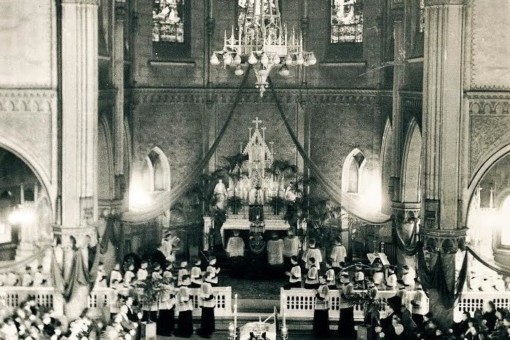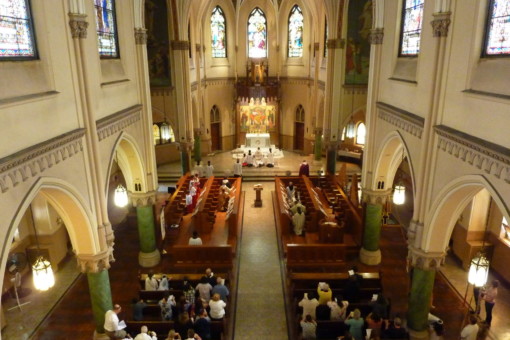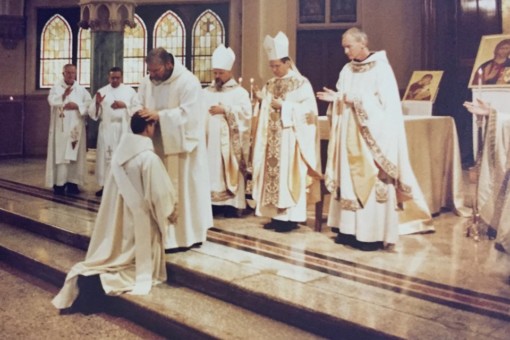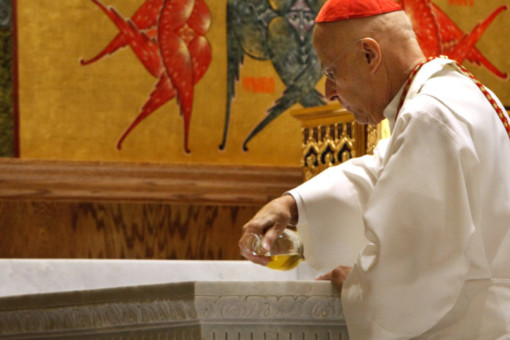Our History
Our three founders began their religious life in the foreign missions. After several years ministering in Haiti and Brazil, they came together to address some of the challenges of evangelization in the modern world. Their belief was that the mission requires a strong liturgical practice and the witness of community life.
In 1986, the founders completed a second novitiate as members of the Community of Jerusalem in Paris. This new congregation sought to bring monastic life into the modern city. When they returned to the United States, they spent three years in a rural Midwest diocese, where they served in parish ministry while laying the groundwork for a new monastery. Permission for a monastic foundation was granted on September 14, 1988, and the new community became the Monastery of the Holy Cross, named after the day’s feast.
The fledgling community found the city that they were seeking when His Eminence Cardinal Joseph Bernadin invited the community to the Archdiocese of Chicago in 1991. The brothers were given the church and convent of the recently closed Immaculate Conception parish. Given a choice of the use of these former parish buildings, the brothers chose the former Immaculate Conception church, both for its nearness to downtown as well as for its remarkable beauty. This beauty was in part hidden, as during the two years of its being closed, the church had been used as a warehouse and had suffered a good deal of damage.
The initial years in Chicago were thus spent renovating the church, including the construction of a loft in the church attic as a space for guests, and establishing a rhythm of liturgical life. Father Thomas-Benedict Baxter served as the Prior in these early years.
In the middle of the 1990’s, the community sought to affiliate itself with the Subiaco Congregation of the Order of Saint Benedict. The Abbey of Christ in the Desert graciously agreed to be our adopted mother-house and sent monks to assist in our Benedictine formation.
On March 25, 2000, the founding members made their Solemn Professions as Benedictine monks. On the same day, the first new member made his first vows.
Over the next few years, the monastery was able to purchase several adjacent properties, allowing us to welcome more guests and accommodate more monks.
Around this time, some friends of the monastery approached Father Brendan and asked for talks on monastic spirituality. The group that gathered for these discussions became the core of the monastery’s Oblate program. Since 1999, many lay persons have become oblates, promising to live a life in keeping with the values of the Rule of Saint Benedict according to their state in the world.
In August of 2004, Prior Peter was blessed to become the third superior in the history of the community.
On December 31, 2011, Abbot Bruno Marin, OSB, former Abbot President of the Subiaco Congregation, erected the Monastery as an autonomous house. Prior Peter was elected by the Monastery Chapter to be the community’s first Conventual Prior on February 4, 2019. He was formally installed on February 6 of the same year.
The community was extremely poor in its early days, and fond memories are told of truckloads of potatoes from friends in rural Minnesota helping the brothers through the winter. There were no choir stalls, and the monks prayed either standing or kneeling upon the floor. The community was early on forced to learn how to beg when the boiler in the church went out at the beginning of winter.
Gradually, as the community grew and stabilized, the distance between the French culture of the Jerusalem model and the realities of the situation in the United States became more and more apparent. In the middle of the 1990’s, the community sought to affiliate itself with the Subiaco Congregation of the Order of Saint Benedict. The Abbey of Christ in the Desert graciously agreed to be our adopted motherhouse and sent monks to assist in our Benedictine formation.
During this time, the community earned its keep through chaplaincies at Chicago hospital and religious communities. Lay brothers were called upon for jobs such as bagging groceries. Eventually, the community found its way into computer work, first converting library card catalogues to computer databases, then editing digital versions of academic books.
As this work was subject to the ups and down of venture capital, the community developed its present work of welcoming travelers in our Bed and Breakfast and retreatants in our guesthouse, as well as selling caskets made by fellow monks.
In March of 2000, the founding members emotionally made their Solemn Professions as Benedictine monks. On the same day, the first new member made his first vows. Over the next few years, the monastery was able to purchase several adjacent properties, allowing us to welcome more guests and accommodate more monks. The community also began chanting a more traditional version of the liturgy.
Around this time, some friends of the monastery approached Father Brendan and asked for talks on monastic spirituality. The group that gathered for these discussions became the core of the monastery’s Oblate program. Since 1999, over twenty lay persons have promised to live a life in keeping with the values of the Rule of Saint Benedict according to their state in the world.
Today, the monastery numbers eight in Solemn Vows, with one in the novitiate and one in temporary profession. In keeping with our contemplative charism (we are usually numbered, with the Carmelites of Des Plaines and the Poor Clares in Lemont, as one of three such communities in the Archdiocese), we chant the full Divine Office and steep ourselves in the ethereal beauty of Gregorian chant.
In fidelity to our mission to the city, we schedule our day to allow the most number of guests, and we pray daily for the bishops, priests and consecrated persons in the Archdiocese, as well as for vocations.
In August of 2004, Prior Peter was blessed to become the third superior in the history of the community.
On December 31, 2011, Abbot Bruno Marin, OSB, former Abbot President of the Subiaco Congregation, erected the Monastery as an autonomous house. Prior Peter was appointed and installed as the community’s first Conventual Prior.




